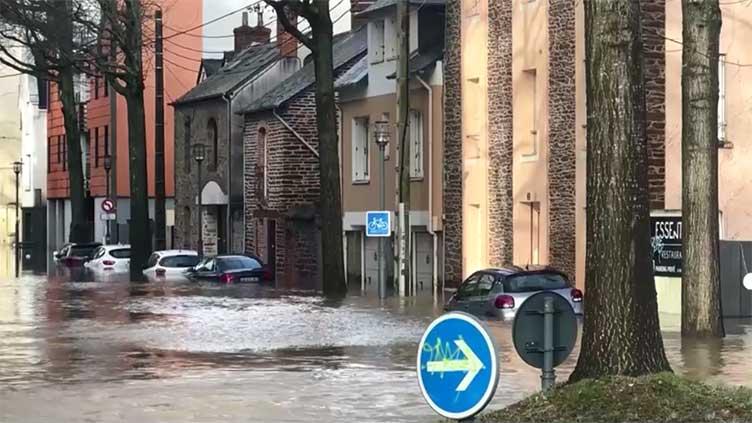Title: Cars Submerged as Storm Herminia Floods Parts of Western France
As Storm Herminia unleashes its fury across western France, the city of Rennes finds itself grappling with the aftermath of severe flooding that has submerged vehicles and disrupted daily life. The intense rain and winds associated with the storm have led to significant water accumulation in several areas, prompting emergency services to spring into action as residents assess the damage. With roadways transformed into rivers and public transport severely impacted, the need for swift recovery efforts is evident. This article delves into the unfolding situation in Rennes, examines the storm’s broader impact on the region, and highlights the resilience of communities facing these extreme weather challenges.
Impact of Storm Herminia on Rennes’ Infrastructure and Local Communities
The aftermath of Storm Herminia has left significant scars on the infrastructure of Rennes, exacerbating the vulnerability of key transport routes and public facilities. Roads that were once bustling with activity are now largely unusable, with localized flooding causing delays and obstructing emergency services. Many drivers found their vehicles submerged, prompting urgent calls for support and highlighting the need for improved drainage systems in the region. City officials are now faced with the daunting task of assessing the damage, which includes:
- Collapsed roadways that pose safety risks to commuters.
- Public transport disruptions, stranding passengers and impacting daily commutes.
- Increased traffic congestion due to detours and road closures.
Local communities are feeling the brunt of the storm’s impact, with many residents evacuated from their homes as floodwaters rise. Relief efforts are underway, but the long-term effects on housing and community spaces may be profound. The storm has drawn attention to the need for greater resilience against climate challenges, with discussions surrounding enhanced urban planning taking center stage. Key areas of concern include:
- Housing vulnerability for communities near riverbanks.
- Emergency response readiness to handle future natural disasters.
- Community recovery programs aimed at rebuilding affected neighborhoods.
Emergency Response Measures and Evacuation Strategies for Residents
In light of the recent devastating flooding in Rennes caused by Storm Herminia, officials urge residents to familiarize themselves with emergency protocols. Immediate safety measures include securing windows and doors, moving to higher ground, and avoiding travel unless absolutely necessary. Residents should stay updated through local weather alerts as well as municipal announcements regarding evacuation orders. Those in flood-prone areas are advised to prepare emergency kits that include essentials such as water, non-perishable food, flashlights, and first aid supplies. Additionally, each household should designate a safe meeting point for family members in case of sudden evacuations.
For effective evacuation strategies, it is vital that residents know their designated evacuation routes, which are often communicated through local authorities. Emergency services will deploy transport options for those without vehicles. In urban regions, check for designated shelters, which may include schools or community centers. To facilitate communication, establish a contact outside the area who can serve as a relay for information if local networks become overwhelmed. Practicing these strategies can significantly enhance safety and prepare residents for future emergencies. Below is a table to help identify key evacuation resources and their contact information.
| Resource | Contact Number | Location |
|---|---|---|
| Emergency Services | 112 | All areas |
| Local Evacuation Centers | (012) 345-6789 | Main Community Center |
| Red Cross Assistance | (012) 987-6543 | City Hall |
Long-term Climate Resilience: Lessons from Recent Flooding Events
As Storm Herminia wreaked havoc across western France, inundating the streets of Rennes and surrounding regions, the need for long-term climate resilience has never been clearer. Such extreme weather events are becoming increasingly common, necessitating a reevaluation of how urban areas prepare for and respond to flooding. Governments and municipalities must prioritize the integration of sustainable infrastructure solutions and disaster response plans, focusing on the following strategies:
- Green infrastructure: Implementing permeable surfaces to enhance water absorption.
- Enhanced drainage systems: Upgrading existing drainage to cope with heavy rainfall.
- Community education: Providing residents with flood preparedness resources.
The economic and social impacts of such flooding incidents highlight the urgency of developing robust recovery methods. As demonstrated during and after the storm, communities often face significant disruptions ranging from transportation logjams to supply chain delays. To mitigate these challenges, local authorities should consider establishing coordinated response frameworks that include:
| Response Strategy | Benefits |
|---|---|
| Task Force Creation | Streamlined communication and resource allocation. |
| Emergency Relief Fund | Quick financial assistance to affected families and businesses. |
| Post-Event Assessments | Identifying vulnerabilities for future planning. |
Recommendations for Vehicle and Property Safety During Severe Weather Alerts
The recent devastation caused by Storm Herminia underscores the urgency for enhancing safety measures during severe weather events. To safeguard vehicles from potential flood damage, it is critical to monitor weather alerts closely and seek higher ground during storms. Avoid parking in low-lying areas prone to flooding and consider using garages or covered structures when available. If you must travel, ensure your vehicle is equipped with essentials, including a flashlight, a first aid kit, and extra food and water supplies. Familiarize yourself with local evacuation routes, and have your car’s fuel tank at least half full in case of emergency evacuations.
Property safety is equally vital in the face of severe weather conditions. Make a checklist of precautions to secure your home, including clearing gutters and downspouts to prevent water buildup. Consider reinforcing doors and windows to withstand high winds and securing outdoor items that could become projectiles. Additionally, establish a communication plan with family and neighbors to ensure everyone is informed and prepared. Implementing these strategies can significantly mitigate risks and protect both vehicles and properties during such unpredictable weather challenges.
In Summary
As the aftermath of Storm Herminia continues to unravel, the city of Rennes and other parts of western France face significant challenges in recovery and restoration. The flooding has not only submerged vehicles but also disrupted daily life, leaving authorities and residents grappling with the extensive damage. With emergency services working tirelessly to address the immediate impact, experts are emphasizing the importance of preparedness for future weather events as climate change intensifies such natural phenomena. As the region begins to assess the full scope of the storm’s impact, it is clear that a communal effort will be essential for rebuilding and ensuring resilience against future storms. Updates on recovery efforts will follow as the situation develops.




